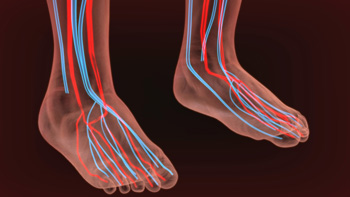Poor circulation in your feet may cause them to feel cold or numb. They may also become discolored, and your legs and ankles may swell up. You can try to improve the circulation in your feet and legs by exercising, which can increase the blood and oxygen your muscles receive. Cutting your salt intake will reduce fluid retention (which restricts circulation). Eating foods that are rich in omega-3 fatty acids is also believed to be helpful. Sitting or standing too long can cause poor circulation in your feet and ankles as well, so try to alternate these positions throughout the day. Avoid wearing high heels or pointy shoes which can also interrupt blood flow to the feet and toes. Poor circulation in the lower extremities may be caused by more serious underlying conditions such as arteriosclerosis, diabetes, peripheral artery disease (PAD), or more. If you are experiencing any symptoms of poor circulation in your feet, ankles, or lower legs, make an appointment with a podiatrist for an examination and evaluation.
While poor circulation itself isn’t a condition; it is a symptom of another underlying health condition you may have. If you have any concerns with poor circulation in your feet contact Philip K. Schrumpf, DPM of Active Feet Clinic. Our doctor will treat your foot and ankle needs.
Poor Circulation in the Feet
Peripheral artery disease (PAD) can potentially lead to poor circulation in the lower extremities. PAD is a condition that causes the blood vessels and arteries to narrow. In a linked condition called atherosclerosis, the arteries stiffen up due to a buildup of plaque in the arteries and blood vessels. These two conditions can cause a decrease in the amount of blood that flows to your extremities, therefore resulting in pain.
Symptoms
Some of the most common symptoms of poor circulation are:
- Numbness
- Tingling
- Throbbing or stinging pain in limbs
- Pain
- Muscle Cramps
Treatment for poor circulation often depends on the underlying condition that causes it. Methods for treatment may include insulin for diabetes, special exercise programs, surgery for varicose veins, or compression socks for swollen legs.
As always, see a podiatrist as he or she will assist in finding a regimen that suits you. A podiatrist can also prescribe you any needed medication.
If you have any questions, please feel free to contact our office located in Missoula, MT . We offer the newest diagnostic and treatment technologies for all your foot care needs.

